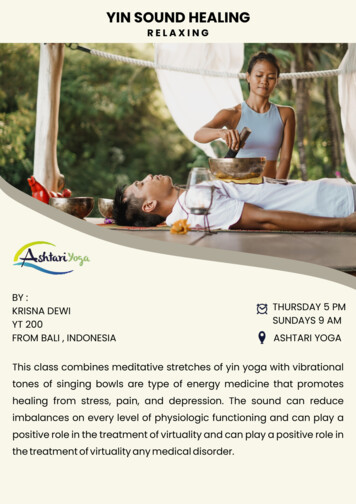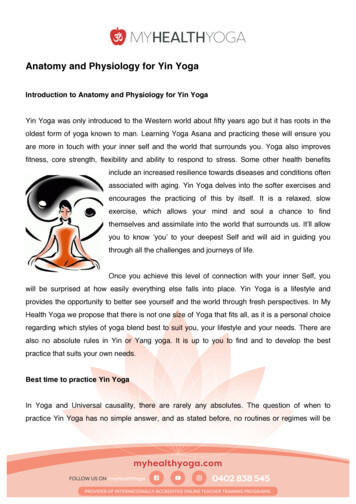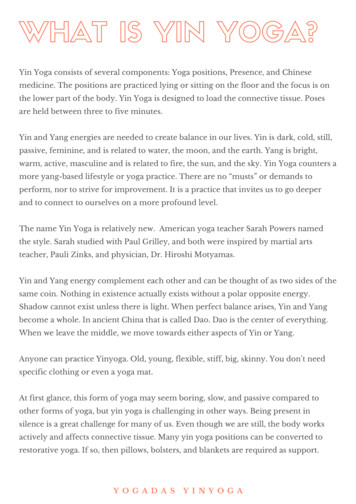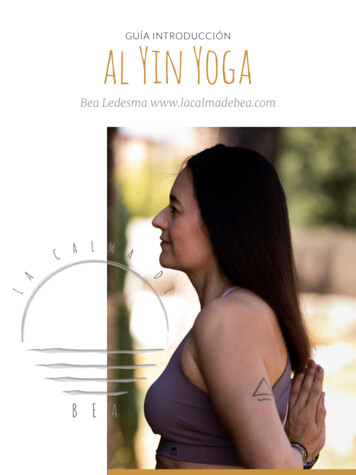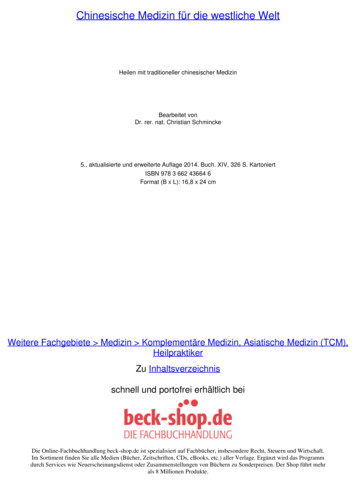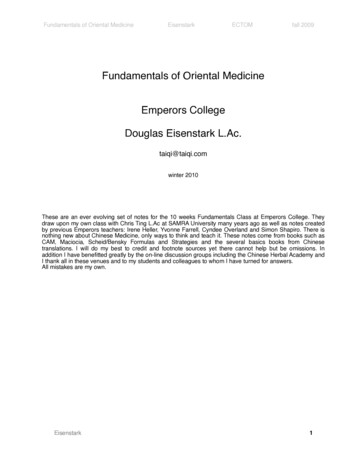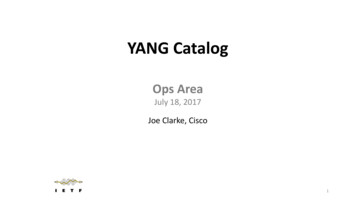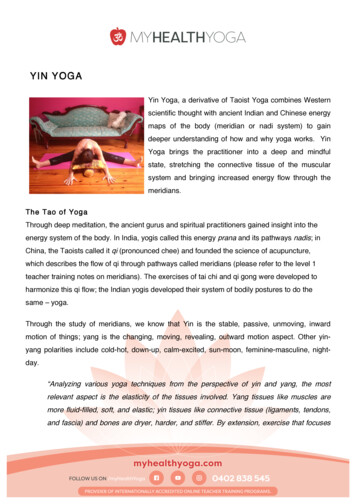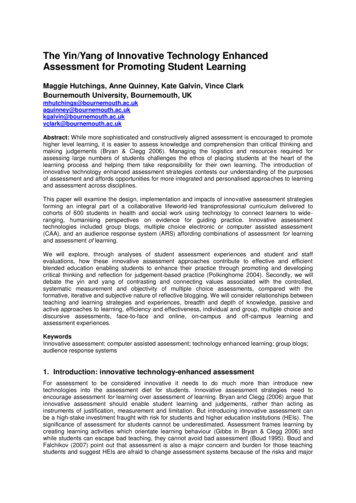
Transcription
The Yin/Yang of Innovative Technology EnhancedAssessment for Promoting Student LearningMaggie Hutchings, Anne Quinney, Kate Galvin, Vince ClarkBournemouth University, Bournemouth, ac.ukAbstract: While more sophisticated and constructively aligned assessment is encouraged to promotehigher level learning, it is easier to assess knowledge and comprehension than critical thinking andmaking judgements (Bryan & Clegg 2006). Managing the logistics and resources required forassessing large numbers of students challenges the ethos of placing students at the heart of thelearning process and helping them take responsibility for their own learning. The introduction ofinnovative technology enhanced assessment strategies contests our understanding of the purposesof assessment and affords opportunities for more integrated and personalised approaches to learningand assessment across disciplines.This paper will examine the design, implementation and impacts of innovative assessment strategiesforming an integral part of a collaborative lifeworld-led transprofessional curriculum delivered tocohorts of 600 students in health and social work using technology to connect learners to wideranging, humanising perspectives on evidence for guiding practice. Innovative assessmenttechnologies included group blogs, multiple choice electronic or computer assisted assessment(CAA), and an audience response system (ARS) affording combinations of assessment for learningand assessment of learning.We will explore, through analyses of student assessment experiences and student and staffevaluations, how these innovative assessment approaches contribute to effective and efficientblended education enabling students to enhance their practice through promoting and developingcritical thinking and reflection for judgement-based practice (Polkinghorne 2004). Secondly, we willdebate the yin and yang of contrasting and connecting values associated with the controlled,systematic measurement and objectivity of multiple choice assessments, compared with theformative, iterative and subjective nature of reflective blogging. We will consider relationships betweenteaching and learning strategies and experiences, breadth and depth of knowledge, passive andactive approaches to learning, efficiency and effectiveness, individual and group, multiple choice anddiscursive assessments, face-to-face and online, on-campus and off-campus learning andassessment experiences.KeywordsInnovative assessment; computer assisted assessment; technology enhanced learning; group blogs;audience response systems1. Introduction: innovative technology-enhanced assessmentFor assessment to be considered innovative it needs to do much more than introduce newtechnologies into the assessment diet for students. Innovative assessment strategies need toencourage assessment for learning over assessment of learning. Bryan and Clegg (2006) argue thatinnovative assessment should enable student learning and judgements, rather than acting asinstruments of justification, measurement and limitation. But introducing innovative assessment canbe a high-stake investment fraught with risk for students and higher education institutions (HEIs). Thesignificance of assessment for students cannot be underestimated. Assessment frames learning bycreating learning activities which orientate learning behaviour (Gibbs in Bryan & Clegg 2006) andwhile students can escape bad teaching, they cannot avoid bad assessment (Boud 1995). Boud andFalchikov (2007) point out that assessment is also a major concern and burden for those teachingstudents and suggest HEIs are afraid to change assessment systems because of the risks and major
effort entailed, leading to slow incremental change, compromise, and inertia. The aspiration forinnovative assessment approaches to provide ways of redefining assessment “as an instrument ofliberation” (Bryan & Clegg 2006, p.1) for both students and HEIs may prove elusive within therealities, challenges, and constraints of organisations.While the value of different forms of technology-based or e-assessment and their potential for offeringlearning benefits to students, through more frequent and immediate feedback, has been recognised,the design and implementation of e-assessments brings major challenges for HEIs (Whitelock 2009).Computer assisted assessment (CAA), encompassing computer-based assessment (CBA) and webbased assessment (WBA), offers immediate scoring and feedback to students and the potential toreduce the marking workload of educators. Initial start-up costs are associated with questionauthoring and review, and development of question banks (Ricketts & Wilks 2002; Deutsch et al2012). Securing and maintaining support of University services including computing, estates,administration and quality assurance (Bull 1999) also needs to be factored in to development andrunning costs. But once the technologies and systems are in place, benefits can be realised forstudents, with online scoring enabling faster and more regular feedback, and for organisations, withautomated marking and feedback offering human resource efficiencies, reducing marking workloadsand ensuring greater accuracy at the point of marking.CAA is associated with provision of multiple choice questions (MCQs) (Bull & Danson 2004). Once adatabank of questions has been developed, the technology enables items to be selected for onlinedelivery, automated scoring and feedback, and report generation. This type of assessment has beendescribed as ‘objective’ but Biggs and Tang (2007, p.203) argue that it is ‘not more scientific’ or anyless prone to error. The potential for error has simply moved from the point of marking to the point ofauthoring questions and response options; this is not necessarily any less subjective than assessingan essay or student presentation. Further the value of MCQs to test anything beyond basicknowledge has been challenged. Biggs and Tang (2007) suggest that while well-designed MCQs canassess higher order learning they are rarely developed in this way. Breadth of learning required toanswer lots of questions challenges the value of MCQs for depth of understanding and as a means ofassessment for learning. Biggs (2007, p. 238) articulates the dangers of CAA where it is used toreinforce the idea that ‘knowing more’ is equated with good learning. The pedagogical foundations fora constructively aligned curriculum where assessment strategies, learning activities and learningoutcomes are clearly aligned are at risk if CAA adopters cannot rise to the challenge of designing anddelivering more sophisticated questions that can assess higher order learning. The yin/yang of CAA ishighlighted here with its main advantages apparently lying in more efficient assessment proceduresbringing organisational and logistical benefits for assessing large student numbers through technologybut calling into question its pedagogical value and effectiveness.Audience response systems (ARS) have been employed in a range of subjects and described as aviable and flexible tool for engaging students in more active learning in classroom settings (Medina etal 2008), by providing rapid feedback about understandings, misunderstandings and clarification(Miller & Hartung 2012, Cain & Robinson 2008), and for testing and evaluation (Mareno et al 2010).Caldwell (2007, p. 2) advises that usage in ‘summative high-stakes testing’ is rare. ARS, or electronicvoting systems (EVS) enable participants to respond to MCQs displayed to the whole class (Draper2009). The aggregated answers, which can be presented using a variety of formats, for example, barcharts or pie charts, are displayed on screen for all to see how responses are distributed acrossoptions. But as with CAA, the pedagogical value of ARS is also questionable, relying as it does onusing MCQs. Draper (2009, p.286-287) describes how the MCQ format has been associated withgame shows like “Who wants to be a millionaire?” where questions are based on ‘the lowest kind oflearning’ of disconnected facts but goes on to identify learning designs that can transcend thisapparent disadvantage.Various claims have been made about online methods of developing skills of critical reflection andcritical thinking through discussion boards and blogs. In dental education Wetmore et al (2010) foundthat whilst blogs did not appear to enhance grades they improved levels of reflection and Hanson(2011) indicated that blogging encouraged group engagement. Goldman et al (2008) evaluated publichealth students’ use of assessed weekly seminar blogs, highlighting opportunities for increasedinteraction, participation and learning. Students positively evaluated “exchanges with other students,hearing different perspectives, flexibility of time of participation, having other students see andcomment on their postings and opinions, helping them stay on top of class work” (Goldman et al
2008, p.2). The ability for technology to provide interactivity and asynchronicity complements theopportunity it also brings for peer-to-peer collaborative learning. Fischer et al (2011) comparedtraditional written assignments to a group blog in medical education, with levels of reflection beingcomparable in both groups, going some way to demonstrate that deeper learning can be facilitatedand evidenced through online shared spaces as well as the more traditional private assignmentwriting.The objective of this study is to examine the design, implementation and impacts of innovativeassessment strategies, with CAA, ARS and blogging, using analyses of student assessments andstudent and staff evaluations to identify the effects on student learning and the implications foreducators. This will lead to a discussion of the yin and yang of innovative assessment, highlightingcontrasts and connections between the controlled, systematic measurement and objectivityassociated with multiple choice assessments, compared with the formative, iterative and subjectivenature of reflective blogging and differences between individual and group assessment.2. Context and method: collaborative lifeworld-led learning strategiesThe introduction of innovative assessment strategies form an integral part of a collaborative lifeworldled transprofessional curriculum delivered to cohorts of 600 students in health and social work wheretechnology has been harnessed to provide a multi-layered blended learning experience, connectinglearners to humanising perspectives for guiding their practice. Assessment technologies included useof group blogs facilitated through BlackboardTM, CAA using Questionmark PerceptionTM and ARSTMusing TurningPoint . The innovative assessment strategies are situated within an undergraduateYear 2 unit, Exploring Evidence to Guide Practice (EE2GP). The humanising philosophy underpinningthe unit encouraged students to integrate understandings about different kinds of knowledge forpractice; conventional evidence, understandings about the person’s experience, and the student’spersonal insights that come from imagining ‘what it is like’ for the person experiencing human services(Galvin & Todres 2011). This was facilitated through a series of 17 web-based case studies providingtopic-related resources for learners to consider experiences of specific illnesses and conditions, suchas dementia, social isolation, and substance misuse through narratives and poems, topic-specificqualitative and quantitative research, and policy and practice issues (Pulman et al 2012). Theseresources were supplemented with face-to-face (f2f) lectures and group work.The intended learning outcomes were constructively aligned with the case study resources andteaching and learning strategies (Biggs & Tang 2007). The students were directed through weeklystudent managed guided learning (SMGL) activities over a four week period (Figure 1) using adetailed guide with tasks and questions to structure and scaffold their learning involving reading,listening, and viewing in preparation for critical reflection and blogging.Figure 1: Weekly student experience
Firstly students were asked to explore what a health or social care condition or situation might be likefor people experiencing it by reading and viewing stories, poems, and videos as evidence drawn fromthe arts and humanities. Secondly, students were asked to examine published research embeddedwithin practice issues relevant to their field through reading and comparing a number of case study,topic-specific, research papers and listening to research active staff, talk about research through shortpodcasts. Thirdly, students were asked to consider how these different kinds of evidence couldusefully guide their practice by comparing, reflecting and demonstrating their knowledge, facilitated bygroup work, which took place face-to-face and through the group blogs.Students, working in groups of six to nine, were allocated case studies relevant to their field of study,Opportunities for considering transprofessional issues of what is required in humanly sensitive care,and associated tensions, risks and dilemmas were facilitated through inter-group discussions.Students, working in their groups, compiled and submitted individual blogs as formative courseworkbased on the weekly SMGL activities and received online formative feedback from educators. Thepurpose of the weekly activities was to enable students to build their knowledge progressively andcollaboratively towards the summatively assessed group coursework blog (50%) and online MCQexamination (50%) at the end of the unit.Building on projects supported by the Higher Education Academy (HEA) (Hutchings et al. 2011) andJISC/SEDA (Hutchings et al 2010b), this study examines the contributions of different forms ofassessment to student learning through analysis of student assessment, feedback and evaluation.Data was collected over a two year period (2011 and 2012) using ARS voting pads to collect regularin-class feedback on the experience of undertaking the unit and an online end of unit evaluation,tailored to the specific features of the unit. The unit was delivered in two blocks each year withapproximately 300 students per block. Data will be identified by cohort year 2011 and 2012 and blocknumbers 1 and 2, ie. 2011.1. The end of unit evaluation included, firstly, a set of item statementsusing a 5-point Likert scale from Strongly Agree to Strongly Disagree; secondly, a series of openresponse questions asking what “enhanced learning”, what “challenged learning”, what they “enjoyedmost”, what they “enjoyed least” and “recommendations for change”. This was deployed immediatelyfollowing the online examination and engendered very high response rates; 2011.1 98% (n 301),2011.2 94% (n 243), 2012.1 86% (n 188) and 2012.2 94% (n 283). Staff evaluation was conductedby means of a staff focus group in 2011 and a questionnaire in 2012. Ethical processes andprocedures were followed.3. Findings: Adoption of innovative assessment strategiesThe design, implementation and impacts of the innovative assessment strategies adopted will beexamined in preparation for discussion of the challenges and implications for student learning,pedagogy, and organisation. The technologies deployed included CAA, ARS, and group blogs,affording combinations of assessment for learning and assessment of learning. We will examine thecontributions of each of these in turn and relate these to our findings.3.1 Computer assisted assessment (CAA)The online MCQ examination consisted of 30 questions, 25 generic research questions and 5 casestudy specific questions, randomised by question and by options. Questions were presented one at atime and students were able to navigate between questions by using buttons to review theirresponses before submission. Students were given one hour to complete the exam; there was an onscreen timer and the exams were invigilated. Students were provided with copies of the journalarticles they had read for their case studies.The technology interface can impact on student acceptance and student performance in CAA.Ricketts and Wilks (2002) found the student assessment interface has a major impact on howacceptable CAA is to students with question-by-question delivery improving student performancecompared with paper tests marked with OMR, where they identified a small improvement, and onlinescrolling, where they identified a large difference. Did the nature of the CAA assessment strategyimpact on the student experience in this study? Student experiences of the online MCQ examinationare identified in Table 1, which lists assessment-related item responses collated from the End of unitevaluation Likert-scale statements. The majority of students were positive about logging on to theMCQ examination (item1) and the user interface with questions identified as easy to read and answeron screen (item 2).
Table 1: End of unit evaluation statementsItemEnd of unit evaluation statements1.Logging on to the multiple choice exam waseasy and 16%Agree/stronglyagree10%70%66%60%Using computerised tests would beappropriate for other summativeassessment in my ronglyagree35%58%58%49%I would prefer the assessment for this unitto be a 3,000 word essay on applyingresearch evidence to practiceDisagree/Strongly %13%I preferred submitting the group courseworkassessment on the computer rather than tronglyagree56%62%59%57%The group blog has been helpful forlearning collaboratively with my nglyagree****48%35%The questions were easy to read andanswer on the computer screen* Statement 4 was included in the ARS for 2011.1 but not the end of unit evaluation.** Statement 6 was not included in the end of unit evaluation for 2011.But our findings also reveal that technical issues impacted adversely on student perceptions of CAA.A comparison of results for 2011.1 (items 1-3) compared with the other cohorts highlights the effectsof technical issues experienced with logging on to the exam using a lockdown browser which delayedexam start times and added to exam anxiety for the 2011.1 block. Deutsch et al (2012) found that apositive CAA experience effects positive attitudinal changes towards the role of CBA, perceived easeof use and perceived objectivity. Our findings agree in showing that those students (2011.1) whoexperienced difficulties with the technology when accessing the online examination were less likely toagree that using computerised tests would be appropriate for other summative assessment (item 3).Building student familiarity with innovative types of assessment is an important factor with studentsconcerned:Having to revise for a test, which is something I am not used to as I am used to preparingpresentations, essays etc.(2012.1)Students were given opportunities weekly to practice MCQ questions and receive feedback in lecturesusing the ARS. This enabled learning through shared feedback contributing to assessment forlearning. Additionally a formative online mock assessment, consisting of 20 questions, was providedfor students to familiarise themselves with the CAA interface in preparation for the summative onlineexamination. But the challenges of the online MCQ examination were relative with the majority of
students in all four cohorts identifying a preference for the innovative assessment strategies adoptedin this unit over the more traditional and familiar 3,000 word essay (item 4).3.2 Audience Response System (ARS)The ARS was used in the lecture theatre, with groups of approximately 300 students with the dualpurpose of gathering opinion and gauging knowledge; through ongoing responses on the experienceof the unit and formative self-assessment in exam preparation. Whilst it enabled students toexperience typical MC exam questions and to gain rapid feedback and clarification it did not providethe facility for multiple responses as would be included in the exam. The overall trend, identified inCaldwell’s (2007) literature review, is that, on the whole, students and educators like the ARS, buteffectiveness is dependent on the pedagogic strategies informing their use (Cain & Robinson 2008;Draper 2009). In our evaluation student responses ranged from those who valued the learningopportunities provided to those who preferred less use of the ARS. The 2012.2 cohort were the mostpositive in their responses, recommending more usage of the ARS. The ability of the ARS to provideinteractivity in large groups, to be enjoyable and provide feedback in order to check learning inpreparation for the exam themes were noted by students, with the ARS providing a bridge betweenthe process of learning, and the outcomes of that learning. The number of questions each week usingthe ARS was reduced in the 2012 cohort, taking into account response times needed to register thevotes for such a large group.The voting pads in lectures made my learning more interactive and engaged my attention so I thoughtthis was useful. (2011.1)The voting pads were fun, and really made me think about what I did and didn't know. (2012.1)3.3 Group blogsThe group blog facility was part of the standard provision in the University’s VLE, enabling the largecohort to be allocated to subgroups of 6-9, with a requirement for weekly individual formative blogcontributions with the facility for intergroup comment and discussion, culminating in a final summativegroup blog. It was complemented by weekly face-to-face group work, with an opportunity to sharelearning with another group. The feedback from students on the helpfulness of the blogs for learningcollaboratively indicated that whilst positive comments outweighed negative comments (Table 1, item6) there was no strong trend in either direction. Themes in the responses included the opportunity togather other opinions and learn from and with peers, acknowledging the opportunity for collaborativelearning, whist some expressed preferences for an individualised approach with expectations ofindividual feedback and a preference for an individual rather than group mark.Learning more about how others interpret the same material and in some ways it improved myunderstanding if there was something I was unsure of. (2012.2)The group blog and posting individual blogs every week helped me to reflect on what I had learnt. Thesmgl were useful in informing what you had to complete each week. (2011.1)Some spoke of tensions within the subgroups in managing both the process and the product of theblog, with others recognising that learning to work effectively in groups represents the reality of healthor social care practice. Some appeared to embrace the use of blogs whist others commented on theunfamiliarity with blogs as an educational tool.Staff feedback indicated that the group blog was: better for assessing 'integration' and 'reflective ability', academic and professional skills that areimportant for the course's central topic: 'exploring evidence for practice'.4. Discussion and ConclusionsStudent statements in the end of unit evaluations reveal significant ying/yang connections andinterrelationships at work in the student experiences of innovative technology-enhanced assessment.The dynamic between breadth and depth of knowledge required and relationships between teachingand learning were clearly demonstrated. Students were challenged both by the depth of knowledge
suggesting it was “complicated to understand” (2011.1) and “extremely difficult” (2012.1) and by itsbreadth:The exam has challenged me; it was a lot of information to take in in 5 weeks as it is such a broadsubject (2011.1)There was so much information I needed to know, I felt very overwhelmed! (2011.1)Gibbs (2006, p.18) argues where CAA is included as a component of assessment, “students tend toadopt a surface approach to their studies (attempting to reproduce) rather than a deep approach(trying to make sense)”, pointing to potential adverse impacts of CAA assessment strategies onstudent learning. However it is significant that student comments relating to this assessment strategywere associated as much with it being an exam as being facilitated through technology, reflected in astudent response to “what I enjoyed least”:The exam, just because it was an exam! (2011.2)Notwithstanding exam anxiety as a factor, the MCQ assessment, consisting as it does of manyquestions on multiple topics, challenges the relationship between breadth and depth and highlightsthe importance of designing questions for deep learning and balancing breadth (numbers ofquestions) with depth (levels of difficulty). The yin yang features and benefits of CAA were identifiedby a member of staff:It was efficient in that it tested both breadth and depth, covering a range of learning that was widerthan I believe an essay would do. I also believe that it was efficient because it reduces theassessment burden on students (compared to a longer assignment), thus freeing their time forlearning.Further, the assessed discursive group blogs provided a dynamic counterbalance andcomplementarity to the controlled, time-limited and ‘objective’ exam. Informed by the unit philosophyof active, collaborative and reflective learning, in line with the shift from teaching to learning, it helps toaddress the concern that MCQ examinations do not facilitate deep learning. The ARS acted as a focalpoint for monitoring research knowledge and understanding and facilitating interactivity, with potentialto be used more to facilitate collaborative and constructivist learning through students workingtogether to debate and choose answers.Our findings also highlight the dynamics of relationships between teaching and learning and theimpact of technology, where students recommended reverting to familiar face-to-face lecture andseminar strategies to improve their exam preparedness:I would have preferred to have structured seminars to prepare us better for the examination. (2012.2)Some students appeared to have unrealistic expectations of the technology or concerns about itsreliability and some emphasised technical problems, potential and real, rather than the capacity tolearn or be assessed differently. Technology was afforded considerable potential yet subjected toscrutiny and criticism with user acceptance fluctuating according to perceived and actual experiences.Readiness for technology-enhanced assessment strategies appeared to be linked to the predominantlearning culture with a lag between what was technically feasible but risky and what was accepted.Benefits can be longer term, as Wyllie (2011) discovered that students who engaged in onlinelearning and assessment became more independent learners, taking more responsibility for their ownand their peers’ learning.The multi-layered blended learning strategy underpinning the unit sought to balance efficiencies witheffectiveness, face-to-face on-campus and online off-campus teaching and learning, group andindividual learning, discursive and MCQ assessment, employing a range of technology enhancedmodes of assessment. Student feedback drew attention to passive and active approaches to learning,particularly in relation to group participation, face-to-face and online. In developing such a complexapproach it is important for HEIs “not to be dazzled or seduced by what the technology can do but toadapt and apply” it to what we want students to be able to do (Quinney 2005, p. 449) in a more radicalshift from just replacing current teaching and learning strategies to transforming the process of
learning, in line with the constructivist pedagogy and learning theory at the root of the EE2GP unit.Hutchings et al (2010a, p.201), in an earlier study, drew attention to experiences of educators whomay be uncertain or unconvinced of the efficacy of disruptive technologies in teaching and learningconcluding that “the challenge is to achieve ‘optimum disruption’, where transformation is seen asachievable and realistic, rather than being experienced as too uncomfortable”. These challenges andassociated risks must be addressed through strategic engagement and co-partnering, at institution,school, programme and unit levels, with management, staff and students, in order to change culturesand practices.AcknowledgementsDevelopment and evaluation of the EE2GP unit was supported by the HEA Discipline-focusedLearning Technology Enhancement Academy (Hutchings et al 2011) and project funding fromJISC/SEDA Embedding Work-with-IT (Hutchings et al. 2010b).ReferencesrdBiggs, J. and Tang, C. (2007) Teaching for Quality Learning at University, 3 ed. Society for Research intoHigher Education & Open University Press.Boud, D. (1995) Enhancing Learning through Self Assessment, London: Kogan Page.Boud, D. and Falchikov. N. (2007) Rethinking Assessment in Higher Education, London: Routledge.Bryan, C. and Clegg, K. (2006) Innovative Assessment in Higher Education, London, Routledge.Bull, J. (1999). “Computer-assisted Assessment: Impact on Higher Education institutions”, EducationalTechnology & Society, Vol. 2, No. 3, pp 123-126.Bull, J. and Danson, M. (2004) Computer-assisted Assessment (CAA), LTSN Generic Centre Assessment SeriesNo 14.Cain, J. and Robinson, E. (2008) “A Primer on Audience Response Systems; Current Applications and FutureConsiderations, American Journal of Pharmaceutical Education, Vol 72, No.4, p 77.Caldwell, J.E. (2007). “Clickers in the Large Classroom: Current Research and Best Practice”, Life SciencesEducation, Vol. 6, No.1, pp 9-20.Deutsch, T., Herrmann, K. Frese, T. and Sandholzer, H. (2012) Implementing Computer
audience response systems 1. Introduction: innovative technology-enhanced assessment For assessment to be considered innovative it needs to do much more than introduce new technologies into the assessment diet for students. Innovative assessment strategies need to encourage assessment for learning over assessment of learning. Bryan and Clegg .



